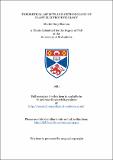Files in this item
Theoretical aspects and methodology of plant electrophysiology
Item metadata
| dc.contributor.advisor | Weeks, David C. | |
| dc.contributor.author | Stanton, Martin Gray | |
| dc.coverage.spatial | 392 p. | en_US |
| dc.date.accessioned | 2018-06-21T13:45:13Z | |
| dc.date.available | 2018-06-21T13:45:13Z | |
| dc.date.issued | 1981 | |
| dc.identifier.uri | https://hdl.handle.net/10023/14405 | |
| dc.description.abstract | Possible sources of electrical transmembrane potentials in living cells are examined. The equations of Nernst, Ussing and Goldman cannot predictively explain the origin of membrane potential because they all require knowledge of concentrations of ions both outside and inside the cell, and these internal concentrations are themselves generated by activity of the cell. Therefore a new electrochemical theory for the steady state has been developed, which takes into account both active transport and the Donnan effect. The theory, which should be general to all living cells, successfully predicts membrane potential in examples examined. Certain hitherto unknown effects have been predicted, the most important of which have been named (a) the "nebenion effect", whereby the presence of other ionic species of the same charge sign as the actively transported ionic species depresses membrane potential, and (b) the "Donnan enhancement effect", whereby the membrane potential when both active transport and a Donnan system co-exist is greater than the sum of the potentials produced by each acting separately. Two important consequences follow ; (i) It is impossible for hydrogen or hydroxyl ion transport to generate a significant membrane potential in the face of environmental concentrations of nebenions. Thus the potential found across any membrane must be due to transport of majority ionic species and/or Donnan effects. (ii) The membrane potential in animal cells can only be explained by the "Donnan enhancement effect" in face of the "nebenion effect". Double Donnan systems and both linked and twin independent transports of two ionic species are considered. The effect of fixed charge either in the cell wail or as 3-potential on either side of the membrane is examined. Experimental procedures for the measurement of membrane potential are examined and a new integral microscope- manipulator system design is presented. Investigations are described of causes, and ways of avoiding, artefacts in measurements with micropipette electrodes, by studies both on model systems and directly on maize root cells. Experimental techniques for the measurement of cell membrane resistance and capacity are reviewed, and a new method is introduced to produce AF impedance spectra of cells, from which both membrane resistance and capacity can be calculated. The electronic system used a phase-sensitive detector to simplify analysis of the a.c. bridge network, as well as to remove noise. It is believed this was in 1973 the first use of such a system in electrophysiology. The technique was tested on dummy circuits to represent the living cell. The properties of micropipette electrodes were investigated. Membrane resistance and capacity were successfully measured in maize root cells. This new technique makes these measurements possible on smaller cells than hitherto, since it uses a lone single-barrelled microelectrode. Finally the significance of such measurements in terms of cell and tissue anatomy is considered, and the theory of "vergence" resistance of small connecting bridges between cells is extended to cover the multiperforate septum. | en_US |
| dc.language.iso | en | en_US |
| dc.publisher | University of St Andrews | |
| dc.subject.lcc | QK845.S8 | en |
| dc.subject.lcsh | Electrophysiology of plants | en |
| dc.title | Theoretical aspects and methodology of plant electrophysiology | en_US |
| dc.type | Thesis | en_US |
| dc.type.qualificationlevel | Doctoral | en_US |
| dc.type.qualificationname | PhD Doctor of Philosophy | en_US |
| dc.publisher.institution | The University of St Andrews | en_US |
This item appears in the following Collection(s)
Items in the St Andrews Research Repository are protected by copyright, with all rights reserved, unless otherwise indicated.

